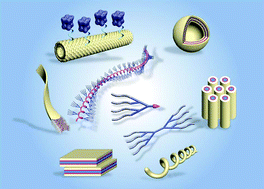Control of the structure and function of self-assembled materials has been a significant issue in many areas of nanoscience. Among many different types of building blocks, dendritic ones have shown interesting self-assembly behaviour and functional performances due to their unique shape and multiple functionalities. Dendritic building blocks exhibit unique self-assembly behaviour in diverse environments such as aqueous and organic solutions, solid–liquid interfaces, and thermotropic solid conditions. Tuning the balance between hydrophilic and hydrophobic parts, as well as the external conditions for self-assembly, provides unique opportunities for control of supramolecular architectures. Furthermore, the introduction of suitable functional moieties into dendrons enables us to control self-assembly characteristics, allowing nanostructures to exhibit smart performances for electronic or biological applications. The self-assembly characteristics of amphiphilic dendrons under various conditions were investigated to elucidate how dendrons can assemble into nanoscopic structures and how these nanoassemblies exhibit unique properties. Well-defined nanostructures derived from self-assembly of dendrons provide an efficient approach for exhibition of unique functions at the nanoscale. This feature article describes the unique self-assembly characteristics of various types of dendritic building blocks and their potential applications as advanced materials.

You have access to this article
 Please wait while we load your content...
Something went wrong. Try again?
Please wait while we load your content...
Something went wrong. Try again?


 Please wait while we load your content...
Please wait while we load your content...